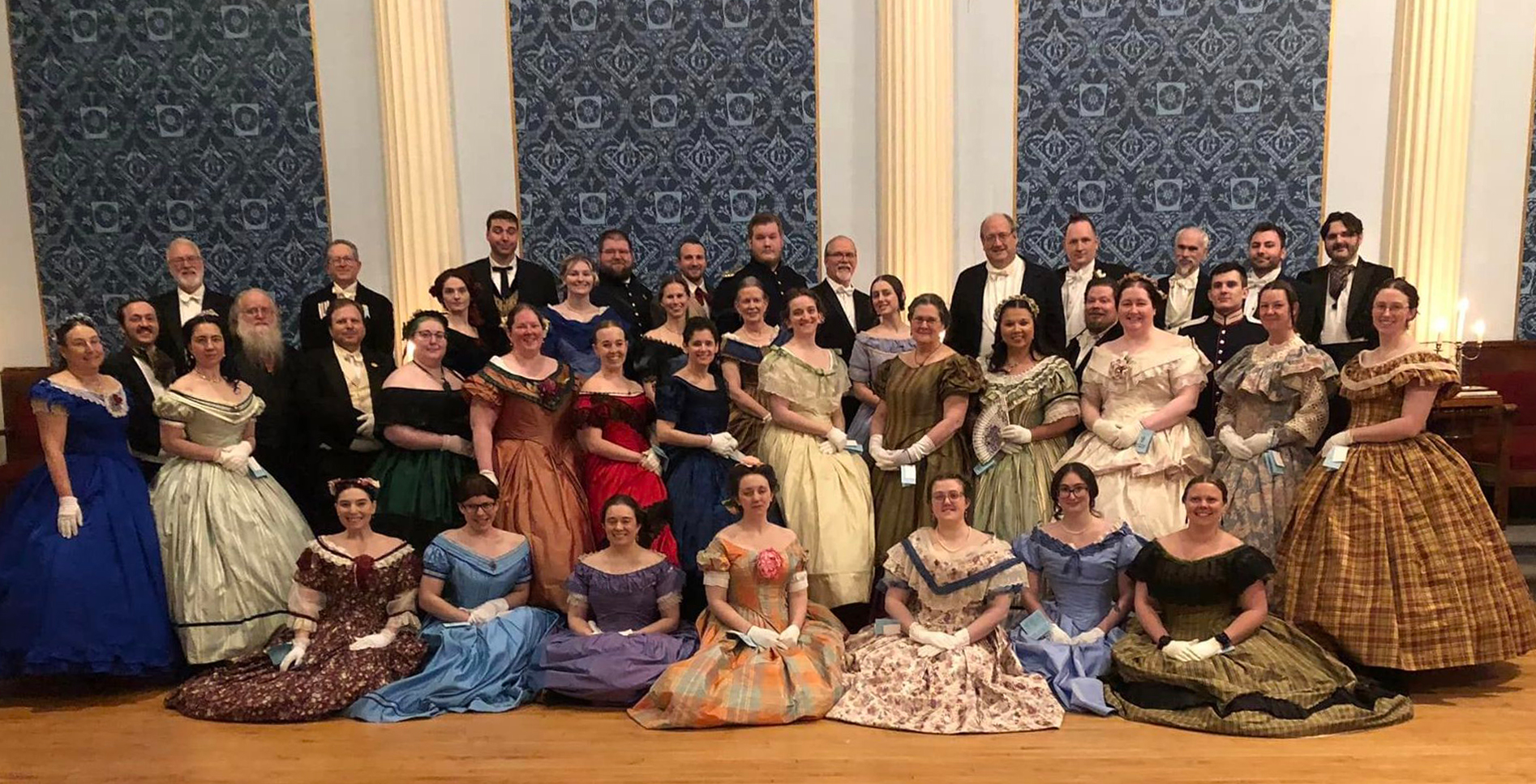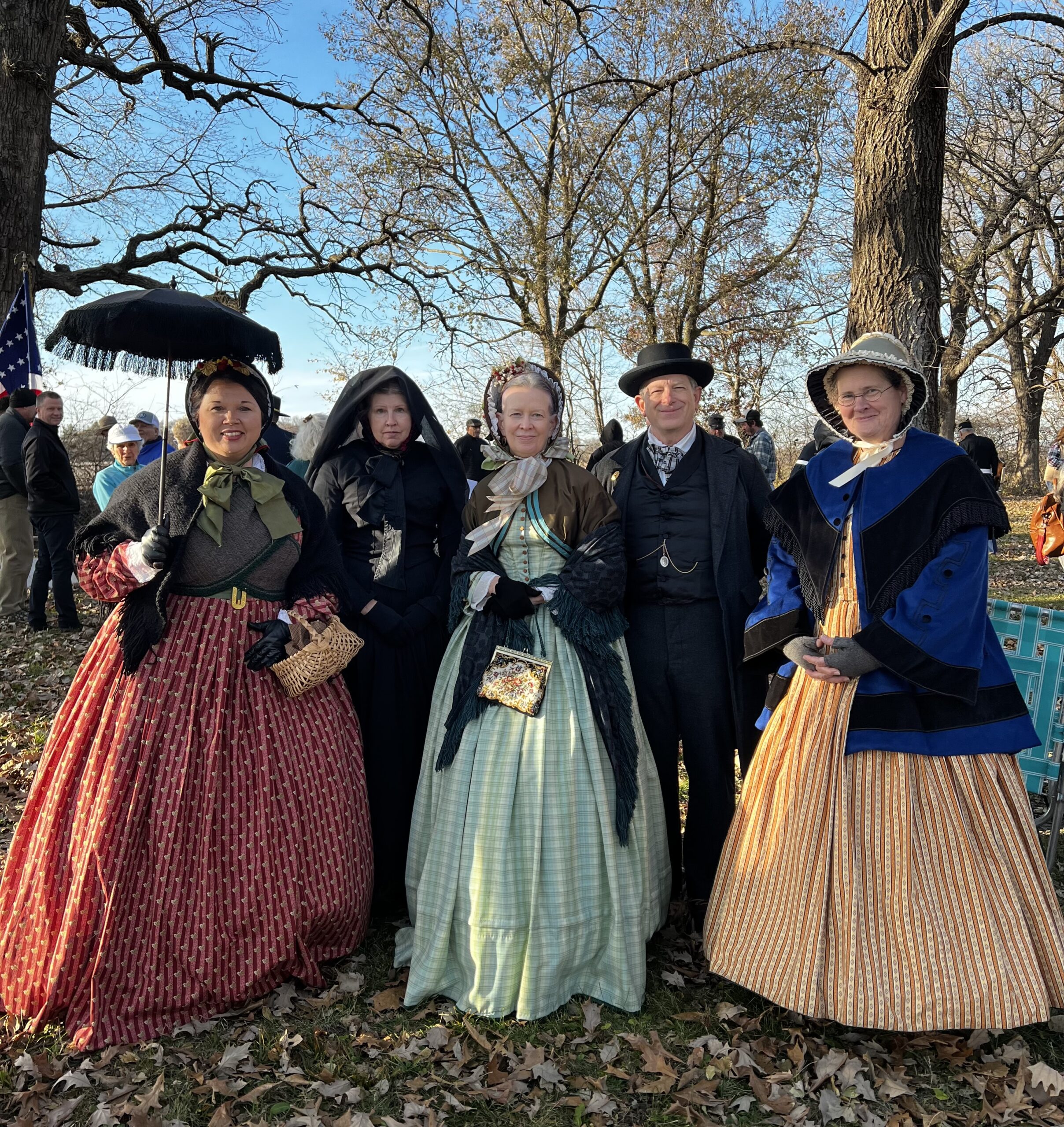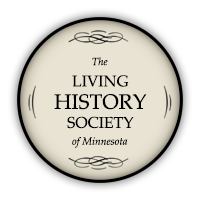
Membership in the Society

Our Mission
The mission of the Living History Society of Minnesota, Inc., is to educate the public as to the lifestyles of mid-19th Century Americans through the accurate portrayal of all walks of civilian life. The main focus for LHS activities centers on the final days of territorial government, through Minnesota’s early statehood (1858), to the end of the Civil War (1865).
Monthly Member Meetings
Meetings for our members are on the first Tuesday of the month at the Maplewood Area Historical Society in Maplewood at 7 p.m.
2170 County Rd D East
Maplewood, MN 55109
A Zoom option is also available. Email lhsmndrive@gmail.com for the link. Please join us!
Membership Benefits
- Mentorship programs give new members the opportunity to work one-on-one with experienced members to learn more about life in mid-19th century Minnesota, and train as a living historian.
- Opportunities to volunteer at historic sites and events.
- Members can participate in dance practices and sewing bees.
- Dance the night away at the Harvest Hop and Winter Weekend — period dance extravaganzas — sponsored by LHS.
- Workshops are offered to help you develop the skills to make your own clothing, bonnets, crinolines, and other items you may need. Past workshops gave insight into 19th century photography, politics of the period, transportation, etiquette, first person interpretation, civilian lifestyles and other topics of interest. We invite local and nationally-recognized presenters. What would you like to learn about or share?
- Our lending wardrobe helps new members dress the part while participating in events.
- Receive event information, group updates, and historical tidbits through the LHS listserv and monthly newsletter.
- We ask all members to help as needed. More involved leadership and mentoring roles are available to established members in good standing. These members run the sewing bees, dance practices, and various events. Membership also votes reliable members to officer positions on the Board.
Becoming a Member
Before making a commitment to join, we suggest that you attend a Living History Society meeting, visit us at an event or email us for information at lhsmndrive@gmail.com.
MEMBERSHIP APPLICATION
Download the 2024–2025 Membership Application (PDF). Please complete it and submit as directed on the application.
MEMBERSHIP DUES
Membership dues are on a yearly basis, with payment due before September 1.
- Individual ($35) — Appropriate for a single member, or households with only one active voting-age member. (“Voting Age” being defined as being 16 years of age or older.)
- Dual-Vote Household ($45) — For households with two or more voting-age members. For each additional voting member (more than 2), please add $5.00.
Living History Society
c/o Maplewood Area Historical Society
2170 County Rd D E
Maplewood, MN 55109
Special Interest Groups

The M&P Railroad Company
As with the original Minnesota & Pacific Railroad, the gentlemen exist in a state of temporary bankruptcy, awaiting action by the state. Solvency shall surely come soon. In the meantime, enjoy this history.
Wasting no time in taking advantage of the February 9, 1857 Federal Land Grant Act, the Minnesota Territorial Legislature created four railroad companies, one of which, the Minnesota & Pacific, incorporated on May 22, 1857. Legally acquiring all the lands available to it required the M&PRR’s construction of a line originating in Stillwater on the St. Croix River, via St. Paul and St. Anthony, to Big Stone Lake on the proposed western border of the soon to be state of Minnesota.
Minnesota’s immigrant population in the ten years preceding statehood grew by 3000%, during a period of rapid expansion and growth in the rest of the region and nation. The Panic of 1857 started in New York early in the year, but Minnesotans remained confident in frontier immunity from cyclical boom and bust cycles, since we did not have as many banks (banks were an evil necessity according to Jacksonian Democrats of the day). However, by late summer hard money had disappeared on the streets of St. Paul, banks closed, and everyone became suspicious of paper money—particularly that which originated anywhere other than the Territory. In this environment the M&PRR could not successfully issue the capital bonds necessary, delaying construction.
Minnesotans looked to a promising harvest and statehood to revive their economy. The depression continued throughout 1858 despite the joyous news of statehood on May 11th. To further stimulate the economy, and to get speedy, reliable transportation, the people approved an amendment to the new state constitution providing four railroad companies access to proceeds of public bonding dollars in the amount of $5 million. Gov. Henry H. Sibley, a Jeffersonian Douglas Democrat, opposed the Five Million Loan as detrimental to the state’s credit rating. The railroad companies petitioned the State Supreme Court for a Writ of Mandamus, a court power that requires a public official to carry out a law. Once granted, Gov. Sibley released the funding against his better judgment. He then set about selling bonds in New York to meager success.
The M&PRR surveyed its line from Stillwater to St. Paul, and then graded and bridged a line from St. Anthony to Crow Wing. It acquired ties, but was unable to afford rails, engines or rolling stock in order to meet terms of the Five Million Loan. The Minnesota Legislature granted an extension due to severe economic times, which provided the company time to consider both its obligations and options. With its first two locomotives commandeered from the assembly shed without remuneration in support of the US Military in the Civil War, by the end of 1860 it needed new investors and more money. The legislature’s extension held, and on January 1, 1862 the M&PRR declared insolvency. The State of Minnesota took over the Railroad, assumed all liabilities and returned all assets to the company under a new name, the St. Paul & Pacific Railroad Company, with all leadership intact. By September, with the help of New York investments, the first operating railroad in the state ran from the lower levee at St. Paul to the Falls of St. Anthony, a distance of ten miles.
The M&PRR succeeded with its corporate structure forever changed by state actions and outside investments. Reorganized, the St.Paul & Pacific operated for several years, eventually folding into James J. Hill’s Great Northern Railway Company, now part of the Burlington Northern Santa Fe Railway. Gov. Sibley did not run again in 1860, and retired from politics until serving one term in the Minnesota House of Representatives in 1871 specifically to fix the bond situation. His bill never passed the Legislature, and he retired from politics permanently, disgusted with the black mark on his gubernatorial record. The state refused the railroad’s bonds and subsequently ruined its own credit rating for 40 years. James J. Hill delivered full repayment of the bonds in the 1880s, though by then the long-term damage remained nearly irreparable. The legacy of the M & PRR leadership depicted as human-headed gophers in an 1857 political cartoon carries on in the state’s nickname, the Gopher State.
Links
- James J. Hill House
- Sibley House Historic Site
- James J. Hill Reference Library
- Lake Superior Railroad Museum which houses the William Crooks, first locomotive on the M&PRR
- Minnesota Transportation Museum
- Minnesota from the Railroad by the Minnesota Historical Society
